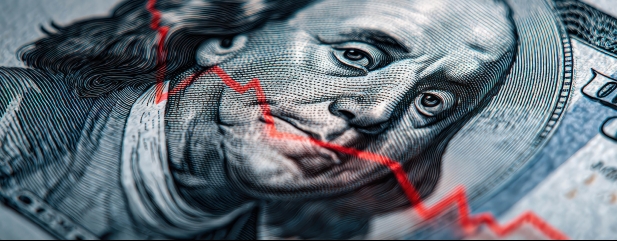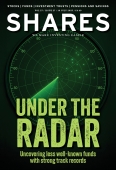Archived article
Please note that tax, investment, pension and ISA rules can change and the information and any views contained in this article may now be inaccurate.
What should investors do about the dollar’s dive?

There are two ways to look at the second Trump presidency.
The first is, there are already only three-and-a-half years to go, while November 2026’s mid-term elections will have a big say in how much, or how little, Trump can get done.
Even a modest swing towards the Democrats would hand them control of Capitol Hill and perhaps force the Republicans to start looking ahead to November 2028’s presidential election and to reassess their political priorities. In sum, ‘this too shall pass,’ as the old saying goes.
The other view is his ‘America first’ policies could have a major impact upon the US, and dollar-denominated assets, and how attractive they are (or otherwise) for investors.
There will be those who stay loyal, in view of the rich rewards gleaned since the Great Financial Crisis ended in 2009 (and frankly beyond then, given America’s rise to global political, economic and military dominance over the past century or so).
Those who harbour doubts may have to ponder how to diversify to best effect, given the US stock market still represents around 60% of global market capitalisation and the greenback is the world’s reserve currency.
A clear choice between those potential scenarios will at least provide investors with a framework for deciding whether current portfolio allocations are sufficiently well balanced to protect, and have the scope to augment, their savings and wealth.
DOLLAR DILEMMA
It is not hard to see why the dollar, as benchmarked by the trade-weighted DXY index, nicknamed ‘Dixie,’ is losing ground in the second Trump presidency.
The White House does not seem wedded to a strong currency, and a weak one could help the plan to onshore industry by rendering exports from local manufacturing more competitive.
Trump continues to call for lower interest rates, even though inflation is still running above the US Federal Reserve’s 2% target more than four years after policymakers argued this was a ‘transitory’ issue.
Some owners of dollar assets may simply be put off by Trump’s use of executive orders, arbitrary decision making and the implications of his proposed Big Beautiful Bill, which looks set to add to a Federal deficit that is already expected to gallop higher.
Further dollar declines therefore are not impossible, especially as the DXY sits a lot nearer the top of its 20-year trading range than the bottom.
That said, currencies do have a habit of self-correcting, as a decline can help exports, drive growth and increase inflation, and thus force higher interest rates which should, by rights, serve to attract capital once more.
Investors must also be aware that the bear case usually seems most compelling at or near the bottom.
EMERGING OPTIONS
Those who do fear, or expect, a weaker dollar, or believe the post-Financial Crisis era of American exceptionalism is ending, may therefore be left looking for alternatives.
It may not therefore require a huge leap of imagination to see why China and Hong Kong, Brazil (and the UK and Europe) sit above the US in terms of stock market performance in 2025 date.
Emerging markets in particular have been in the doldrums for so long and they still offer long-term growth potential.
Research from GaveKal and Aubrey Capital Management shows 69 of the world’s 100 biggest cities lie within a four-hour flight of Hong Kong, a circle which holds half the world’s population.
Demographic trends are favourable, income trends are positive and technological innovation is evident in everything from China’s excellence in electric vehicle batteries to Indian prowess in software development.
Those with a keen sense of market history will also be aware of the historical inverse relationship between the dollar and emerging market equities.
The past is no guarantee for the future, but a softer greenback has tended to help emerging markets in the past, as it eases the burden on developing economies’ overseas debts and enables them to spend the money on themselves rather than on interest for lenders.
RAW DEAL
Another asset class which has tended to do well during times of dollar weakness is commodities, not least because they are priced in the US currency.
They become cheaper to non-dollar users and lower prices tend to fuel higher demand, though again, there is no certainty this pattern will repeat itself even if the dollar does go lower.
Gold’s all-time high may be no coincidence, but it may also deter contrarians from getting heavily involved now.
Silver, oil and platinum, to name but three, look cheap relative to gold on a historic basis, and the wider CRB Commodities index continues to outperform equities almost unnoticed, some five years after forming a bottom relative to the FTSE All-World equity benchmark.
Important information:
These articles are provided by Shares magazine which is published by AJ Bell Media, a part of AJ Bell. Shares is not written by AJ Bell.
Shares is provided for your general information and use and is not a personal recommendation to invest. It is not intended to be relied upon by you in making or not making any investment decisions. The investments referred to in these articles will not be suitable for all investors. If in doubt please seek appropriate independent financial advice.
Investors acting on the information in these articles do so at their own risk and AJ Bell Media and its staff do not accept liability for losses suffered by investors as a result of their investment decisions.
Issue contents
Editor's View
Feature
Great Ideas
Investment Trusts
News
- Currys shares climb to three-year high on resumption of dividends
- Scorching weather takes its toll on Hollywood Bowl
- Frasers Group targets Hugo Boss dividend policy and treasury shares
- Stock markets react with relief as tariff deadlines extended
- Musk risks alienating supporters with new political intervention
 magazine
magazine








